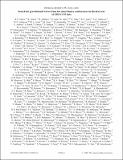Search for gravitational waves from low mass binary coalescences in the first year of LIGO’s S5 data
Author(s)
Wipf, Christopher C.; Weiss, Rainer; Waldman, Samuel J.; Stein, Leo Chaim; Stein, Andrew J.; Smith, Nicolas de Mateo; Shapiro, B.; Sarin, P.; Markowitz, Jared John; Katsavounidis, Erotokritos; Hughey, Brennan J.; Harry, Gregory; Grimaldi, F.; Goda, K.; Foley, Stephany; Duke, I.; Cao, Junwei; Brunet, G.; Blackburn, Lindy L.; Barsotti, Lisa; Mavalvala, Nergis; Zucker, Michael E; Shoemaker, David H; Mittleman, Richard K; Mason, Kenneth R; MacInnis, Myron E; Fritschel, Peter K; Evans, Matthew J; Donovan, Frederick J; Corbitt, Thomas R; Bodiya, Timothy P.; ... Show more Show less
DownloadAbbott-2009-Search for gravitati.pdf (754.7Kb)
PUBLISHER_POLICY
Publisher Policy
Article is made available in accordance with the publisher's policy and may be subject to US copyright law. Please refer to the publisher's site for terms of use.
Terms of use
Metadata
Show full item recordAbstract
We have searched for gravitational waves from coalescing low mass compact binary systems with a total mass between 2M[subscript ⊙] and 35M[subscript ⊙] and a minimum component mass of 1M[subscript ⊙] using data from the first year of the fifth science run of the three LIGO detectors, operating at design sensitivity. Depending on the mass, we are sensitive to coalescences as far as 150 Mpc from the Earth. No gravitational-wave signals were observed above the expected background. Assuming a population of compact binary objects with a Gaussian mass distribution representing binary neutron star systems, black hole–neutron star binary systems, and binary black hole systems, we calculate the 90% confidence upper limit on the rate of coalescences to be 3.9×10[superscript -2] yr-1L[subscript 10][superscript -1], 1.1×10[superscript -2] yr-1L[subscript 10][superscript -1], and 2.5×10[superscript -3] yr-1L[subscript 10][superscript -1], respectively, where L[subscript 10] is 10[superscript 10] times the blue solar luminosity. We also set improved upper limits on the rate of compact binary coalescences per unit blue-light luminosity, as a function of mass.
Date issued
2009-06Department
Massachusetts Institute of Technology. Department of Physics; MIT Kavli Institute for Astrophysics and Space ResearchJournal
Physical Review D
Publisher
American Physical Society
Citation
LIGO Scientific Collaboration et al. “Search for gravitational waves from low mass binary coalescences in the first year of LIGO's S5 data.” Physical Review D 79.12 (2009): 122001. © 2009 The American Physical Society
Version: Final published version
ISSN
1550-2368
1550-7998